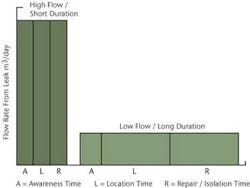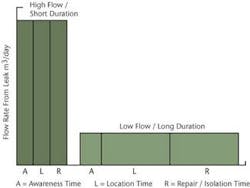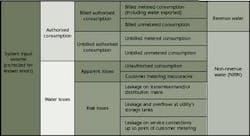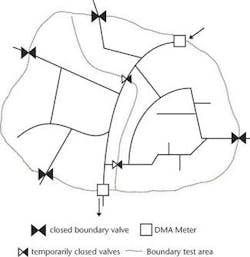Understanding and managing losses in water distribution networks
By Malcolm Farley
Water loss from the pipe network, always the bete noire of the operations engineer, has long been a feature of operations management, even in countries with a well-developed infrastructure and good operating practices; however losses take on a new dimension in developing countries where poor infrastructure, poor sanitation, and intermittent supplies can pose a serious health risk.
Not all losses result from poor infrastructure and leaking pipes. "Appa-rent" losses from the network and excessive use or misuse of water often result from local customs, combined with low tariff structures or inadequate metering policies. The introduction of demand management and water conservation programmes alongside initiatives to tackle leakage and improve the pipe network can often reduce these losses and water overuse. Together, these programmes form a strategy for restoring a potentially huge lost resource.
The key to developing a water loss strategy is to gain a better understanding of the reasons for losses and the factors that influence them. Tech-niques and procedures can then be developed and tailored to specific network characteristics and local influencing factors to tackle each of the causes in order of priority.
Strategy for water loss management.
A diagnostic approach, followed by the practical implementation of solutions that are achievable, can be applied to any water company, anywhere in the world, to develop a water loss management strategy. Consultants working in developing countries will invariably face a slower pace, greater financial constraints, less developed infrastructure, lower levels of skills and technology, and political, cultural and social influences. These all have an influence on the scope for managing losses and demand, and affect the pace at which changes can be made, but the aim should always be to make some improvement to current operational practice by transferring information, new skills and motivation.
The first step in developing a strategy is to ask questions about network characteristics and operating practices, and then use available tools and mechanisms to suggest appropriate solutions, which are used to formulate the strategy.
Typical questions (with the strategic answers) are -
• How much water is being lost? Calculate a water balance.
• Where is it being lost? Conduct a network audit.
• Why is it being lost? Review network practices.
• What strategies can be introduced to reduce losses and improve performance? Develop leakage control strategies and address policies.
• How can we maintain the strategy and sustain the achievements gained? Implement training and operating and maintenance programmes.
Defining water loss and leakage
Water loss occurs in all distribution systems - only the volume of loss varies. This depends on the characteristics of the pipe network and other local factors, the water company's operational practice, and the level of technology and expertise applied to controlling loss. The volume lost varies widely from country to country, and between regions of each country. The components of water loss, and their relative significance, also vary between countries. One of the cornerstones of a water loss strategy is therefore to understand the relative significance of each of the components, ensuring that each is measured or estimated as accurately as possible, so that priorities can be set via a series of action plans.
The expressions "total water loss" and "non-revenue water" are now internationally accepted, and have replaced expressions such as "unaccounted-for water" (UFW), which are less consistent and make inter-country comparisons more difficult. Total water loss is calculated by subtracting the amount of water billed or consumed from the amount of water produced.
It is important to differentiate between total water loss and leakage.
Real losses comprise leakage from pipes, joints and fittings, from leaking reservoir walls, and from reservoir overflows. Apparent losses consist of unauthorised consumption and all types of metering inaccuracies. Real losses can be severe and may go undetected for months or even years. The volume lost will depend largely on the characteristics of the pipe network and the leak detection and repair policy practised by the company, such as:
• pressure in the network;
• frequency and typical flow rates of new leaks and bursts;
• proportions of new leaks which are 'reported';
• awareness time (how quickly the loss is noticed);
• location time (how quickly each new leak is located);
• repair time (how quickly it is repaired or shut off);
• level of background leakage (undetectable small leaks).
The relative volumes of water loss over time from different parts of the network are illustrated in Figure 1. For example, a burst distribution main would normally be repaired or shut off immediately, but an underground service pipe leak could be undetected for months. Leakage is usually the major component of water loss in developed countries, but this is not always the case in developing or partially developed countries, where illegal connections, meter error, or accounting errors are often more significant.
Assessing losses
Water loss can be determined by conducting a water balance, which is based on the measurement or estimation of water produced, imported, exported, consumed or lost. The calculation should balance. Most water companies are able to provide estimates of production, imports, exports and consumption, but less able to estimate the other components. The water balance calculation provides a guide to how much is lost as leakage from the network (real losses), and how much is due to apparent or non-physical losses.
There has been an urgent need for a common international terminology because of the wide diversity of formats and definitions used for water balance calculations internationally (often within the same country). Drawing on the best practice from many countries, the International Water Association (IWA) Task Forces on Water Losses and Performance Indicators recently produced an international best practice standard approach for Water Balance calculations (Figure 2), with definitions of all terms involved.
Developing a strategy
A water balance should identify the priorities to address in a water loss strategy. Infrastructure improvement and a programme of active leakage control will, in most networks, directly reduce real losses or leakage. A programme to address apparent losses will usually be dependent on longer term changes to metering, regulatory and legislative policies.
Active leakage control is when company staff employees are deployed to find leaks, which have not been reported by customers or other means. One of the planks of active leakage control is zonal monitoring or district metering. This requires the installation of flow meters at strategic points throughout the distribution network, each meter recording flows into a discrete district meter area (DMA), which has a defined and permanent boundary. Inspectors are then deployed to locate leaks with specialist equipment in culprit DMAs. A typical DMA is illustrated in Figure 3. Pressure management can be undertaken in conjunction with district metering or when establishing supply zones. Good pressure management will reduce bursts and leakage, and will also result in more stable pressures, causing less strain on the pipe network, and less chance of fatigue damage at joints.
The main factor governing choice of leakage control method is the value of the water, which determines whether a particular methodology is economic for the savings achieved. A low activity method, such as repair of visible leaks only, may be cost-effective in supply areas where water is plentiful and cheap to produce. Countries that have a high cost of production and supply can justify a much higher level of activity, such as continual flow monitoring, or even telemetry systems, to warn of a burst or leakage occurring.
IWA Publishing recently published the book Losses in Water Distribution Networks - a Practitioner's Guide to Assessment, Monitoring and Control, written by M. Farley and S. Trow, which addresses
in detail the steps required to design and implement a water loss reduction strategy. It deals with the questions, tasks and
solutions for each step.
It is designed for readers to dip into each chapter according to their need for information and the level of advancement in the strategy process. For example, those practitioners with less developed networks and fewer resources can proceed to the later chapters on upgrading the network and designing leakage control and pressure control systems before embarking on the more detailed data analysis required for strategy development.
For more information visit the website: www.iwapublishing.com.
Author's NoteMalcolm Farley, based in Bampton, Oxfordshire, England, specialises in water loss management, and operation and maintenance of supply and distribution networks worldwide. Farley works with Aqua2, a water engineering consultancy. An accomplished writer, Farley has written several definitive manuals and books on this topic, including the latest "Losses in Water Distribution Networks," a best practice manual on measuring, monitoring and controlling losses for the IWA, published in early 2003. For more information, contact the author at [email protected].



